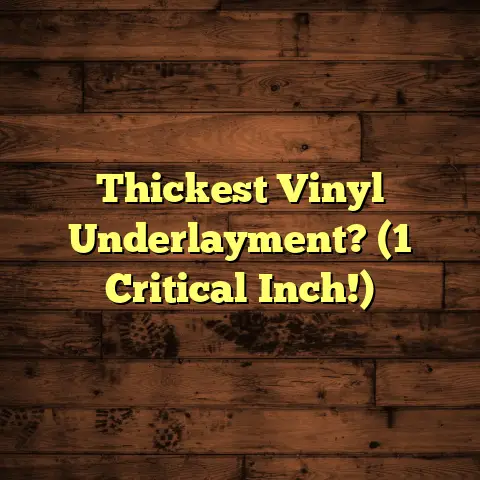Floor Trusses vs. I-Joists Cost? (Save $ Soon!)
Ever been knee-deep in a building project, sweating over every penny, only to be blindsided by flooring costs?
I’ve seen it happen countless times.
One homeowner I worked with, let’s call him Mark, was building his dream home.
He’d meticulously planned every detail, but the floor system choice almost derailed the entire project.
He was torn between floor trusses and I-joists, and the cost difference was a real head-scratcher.
This article is for Mark, and for you.
Let’s dive deep into the world of floor trusses and I-joists, break down the costs, and figure out how to save some serious cash.
1. Understanding Floor Trusses and I-Joists
So, what exactly are floor trusses and I-joists?
Think of them as the unsung heroes supporting your every step.
Floor Trusses: These are engineered structures, typically made of wood, that form a triangular web-like pattern.
They’re strong, lightweight, and can span long distances without needing support.
I-Joists: As the name suggests, these resemble the letter “I.”
They consist of top and bottom flanges, usually made of solid lumber or laminated veneer lumber (LVL), connected by a web, often made of oriented strand board (OSB).
Structural Differences:
The key difference lies in their design.
Trusses distribute weight across multiple points, making them incredibly strong for long spans.
I-joists, while strong, rely more on the strength of their flanges and web.
This affects their load-bearing capabilities and how they handle deflection (bending).
Think of it like this: a truss is like a suspension bridge, while an I-joist is more like a solid beam.
The installation process also differs.
Trusses often require specialized equipment for lifting and placement, while I-joists are generally easier to handle.
2. Cost Breakdown
Alright, let’s get down to brass tacks: the money.
I’ve seen costs vary wildly depending on location, material prices, and project complexity.
But let’s look at some ballpark figures.
Material Costs (per square foot):
- Floor Trusses: $4 – $8
- I-Joists: $3 – $6
Now, these are just averages.
The type of wood used, the complexity of the design, and even the season can affect these numbers.
Labor Costs for Installation:
- Floor Trusses: $1 – $3 per square foot
- I-Joists: $0.75 – $2 per square foot
Why the difference?
Trusses often require a crane or specialized lifting equipment, which adds to the labor cost.
I-joists are generally lighter and easier to maneuver, reducing installation time and labor expenses.
Long-Term Maintenance and Repair Costs:
This is where things get interesting.
Both trusses and I-joists are pretty durable, but they’re not invincible.
If a truss gets damaged, it might require specialized repair or even replacement of the entire unit.
I-joists, on the other hand, are often easier to repair locally.
You might be able to sister a new piece of lumber alongside the damaged section.
Real-World Examples:
I worked on a project recently, a 2,500 square foot house in rural Iowa.
Using floor trusses, the material cost was around $15,000, and labor was $5,000.
For a similar project using I-joists, the material cost was $12,500, and labor was $3,750.
That’s a difference of over $3,750!
3. Factors Influencing Cost
So, what makes the price of trusses and I-joists fluctuate?
It’s not just about the materials themselves.
Geographic Location:
I’ve noticed significant price variations depending on where you are in the country.
Areas with a high demand for lumber or limited supply chains will naturally have higher prices.
Availability of Materials and Local Suppliers:
If you’re in a remote area with only one lumberyard, you’re at their mercy.
Getting quotes from multiple suppliers can save you a surprising amount of money.
Project Complexity and Design Specifications:
A simple rectangular floor plan will be cheaper than a complex design with multiple angles and curves.
The span (distance between supports) also matters.
Longer spans require stronger, more expensive trusses or I-joists.
I remember one project where the architect specified unusually long spans, driving up the cost significantly.
We ended up re-evaluating the design and adding a support beam, which saved the client thousands.
4. Performance vs. Cost
It’s tempting to just go with the cheapest option, right?
But performance matters just as much as cost.
Load Distribution and Structural Integrity:
Trusses generally excel at distributing weight evenly, making them ideal for large open spaces.
I-joists are strong, but they might require more frequent supports for the same span.
Acoustic Performance and Sound Insulation:
Here’s a little secret: neither trusses nor I-joists are inherently great at sound insulation.
Sound travels easily through wood.
However, you can improve the acoustic performance by adding insulation between the joists or trusses.
Thermal Performance and Energy Efficiency:
Again, the wood itself isn’t a great insulator.
But the space between the trusses or I-joists provides an excellent opportunity to add insulation, improving your home’s energy efficiency.
Cost-Saving Tip:
Consider using a combination of trusses and I-joists.
For example, use trusses for long spans in the living room and I-joists for shorter spans in the bedrooms.
This can optimize both performance and cost.
5. Installation Considerations
Installation can be a major factor in the overall cost and timeline of your project.
Time Required for Installation:
I-joists are generally faster to install than trusses, especially for smaller projects.
Complexity of the Installation Process:
Trusses often require specialized equipment and a skilled crew.
I-joists are more DIY-friendly, although I always recommend hiring a professional.
Equipment and Tools Needed:
For trusses, you’ll likely need a crane or forklift.
For I-joists, you’ll need basic carpentry tools like saws, drills, and levels.
Pro Tip:
Proper planning is key.
Make sure you have a detailed installation plan and that your crew is experienced with the type of flooring system you’re using.
A mistake during installation can be costly to fix.
6. Long-Term Cost Implications
Think beyond the initial purchase price.
What will these floors cost you down the road?
Lifespan and Durability:
Both trusses and I-joists can last for decades if properly installed and maintained.
However, they’re both susceptible to moisture damage and insect infestation.
Cost of Repairs and Replacements:
As I mentioned earlier, repairing a damaged truss can be more expensive than repairing an I-joist.
Resale Value of Homes:
While the type of flooring system isn’t usually a major selling point, a structurally sound and well-insulated floor can definitely add value to your home.
Expert Opinion:
I spoke with a structural engineer friend of mine, Sarah, about the long-term implications.
She emphasized the importance of proper design and installation.
“A poorly designed truss system can fail prematurely, leading to costly repairs,” she said.
“Similarly, if I-joists aren’t properly spaced or supported, they can deflect excessively, causing problems with the flooring above.”
7. Real-Life Examples and Case Studies
Let’s hear from people who’ve been there, done that.
Success Story:
I worked with a builder, Tom, who exclusively uses floor trusses.
He says they save him time and money on large, open-concept homes.
“The long spans we can achieve with trusses eliminate the need for support beams, which simplifies the design and reduces construction costs,” he told me.
Cautionary Tale:
Another contractor, Maria, had a bad experience with I-joists that weren’t properly installed.
“The floors felt bouncy and uneven,” she said.
“We had to tear out the entire flooring system and start over, which was a huge expense and a major headache.”
Homeowner Testimonial:
A homeowner I know, David, chose I-joists for his new home because they were more affordable.
He’s happy with the performance, but he admits he wishes he had spent a little more on sound insulation.
“I can hear every footstep upstairs,” he said.
“It’s not a deal-breaker, but it’s something I would have considered more carefully.”
8. Conclusion
Choosing between floor trusses and I-joists is a big decision.
It’s not just about the initial cost; it’s about performance, long-term durability, and your specific project needs.
I’ve walked you through the key considerations, from material costs to installation complexities to long-term implications.
Remember Mark, the homeowner from the beginning?
He ultimately chose I-joists for his project, but only after carefully weighing the pros and cons.
He saved money upfront, but he also invested in extra sound insulation to address his concerns about acoustic performance.
The key takeaway?
Do your research, get multiple quotes, and don’t be afraid to ask questions.
An informed choice can save you money, reduce headaches, and ensure that your floors are strong, safe, and sound for years to come.
So, are you ready to save some money on your next flooring project?





